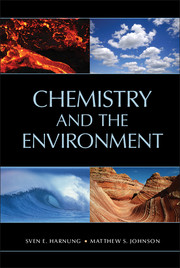Book contents
- Frontmatter
- Contents
- Preface
- Acknowledgments
- Chemistry and the Environment
- Introduction
- 1 The Earth
- 2 Environmental dynamics
- 3 The Spheres
- 4 Chemistry of the atmosphere
- 5 Chemistry of the hydrosphere
- 6 Chemistry of the pedosphere
- 7 Global cycles of the elements
- 8 The chemicals industry
- 9 Environmental impact of selected chemicals
- 10 The chemistry of climate change
- Appendix 1
- Appendix 2
- Appendix 3
- Appendix 4
- Appendix 5
- References
- Name index
- Subject index
- Miscellaneous Endmatter
- References
9 - Environmental impact of selected chemicals
Published online by Cambridge University Press: 05 November 2012
- Frontmatter
- Contents
- Preface
- Acknowledgments
- Chemistry and the Environment
- Introduction
- 1 The Earth
- 2 Environmental dynamics
- 3 The Spheres
- 4 Chemistry of the atmosphere
- 5 Chemistry of the hydrosphere
- 6 Chemistry of the pedosphere
- 7 Global cycles of the elements
- 8 The chemicals industry
- 9 Environmental impact of selected chemicals
- 10 The chemistry of climate change
- Appendix 1
- Appendix 2
- Appendix 3
- Appendix 4
- Appendix 5
- References
- Name index
- Subject index
- Miscellaneous Endmatter
- References
Summary
Industrial chemicals may be broadly classified as commodity chemicals (see Table 8.1) and specialty chemicals (Table 9.1). The two classes are not exact, but they may be characterized as bulk chemicals (produced in large volume) and fine chemicals (produced in low volume), respectively.
The most important specialty chemicals are listed in Table 9.1. The list is in decreasing order of mass fraction per year, around 2009. An assessment of the actual values is difficult because (1) the delimitation of each group depends on the source of the data, and (2) whereas most data are well known for the United States and the European Union, they are less precise for developing countries. A global production rate of 1 Tg/a corresponds to an average consumption rate of 150 g/a per human being.
The environmental problems that have driven the development of environmental chemistry are associated with the production of goods that we would not want to do without. Industrial production has been built up sequentially: each advance builds on what has come before. One may therefore expect that environmental problems, documented with help from analytical chemistry and spectroscopy, can be solved using the same empirical process. Many compounds either have been phased out or are the subject of regulation. One example is the chlorofluorocarbons described in Chapter 4; another is the pesticides listed in Table 9.2. By the end of the 20th century, useful alternatives had been found for tetraethyl lead, an antiknock additive in gasoline, and its use has been banned (an example of the toxicity of lead can be found in Section 1.3c). The field of environmental chemistry is changing as its focus moves from one pollutant to the next.
- Type
- Chapter
- Information
- Chemistry and the Environment , pp. 310 - 342Publisher: Cambridge University PressPrint publication year: 2012



